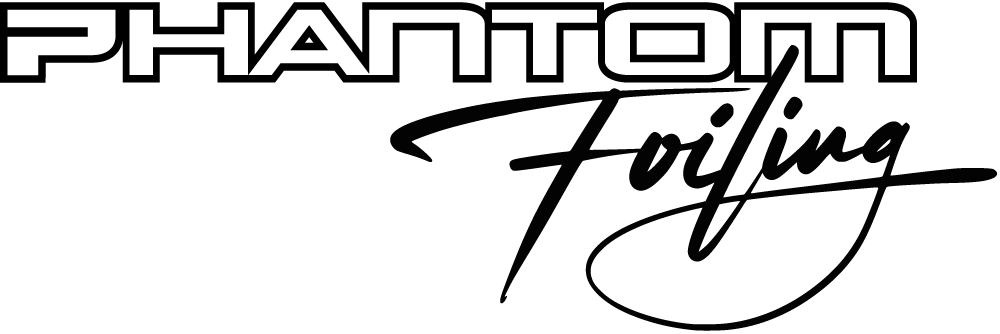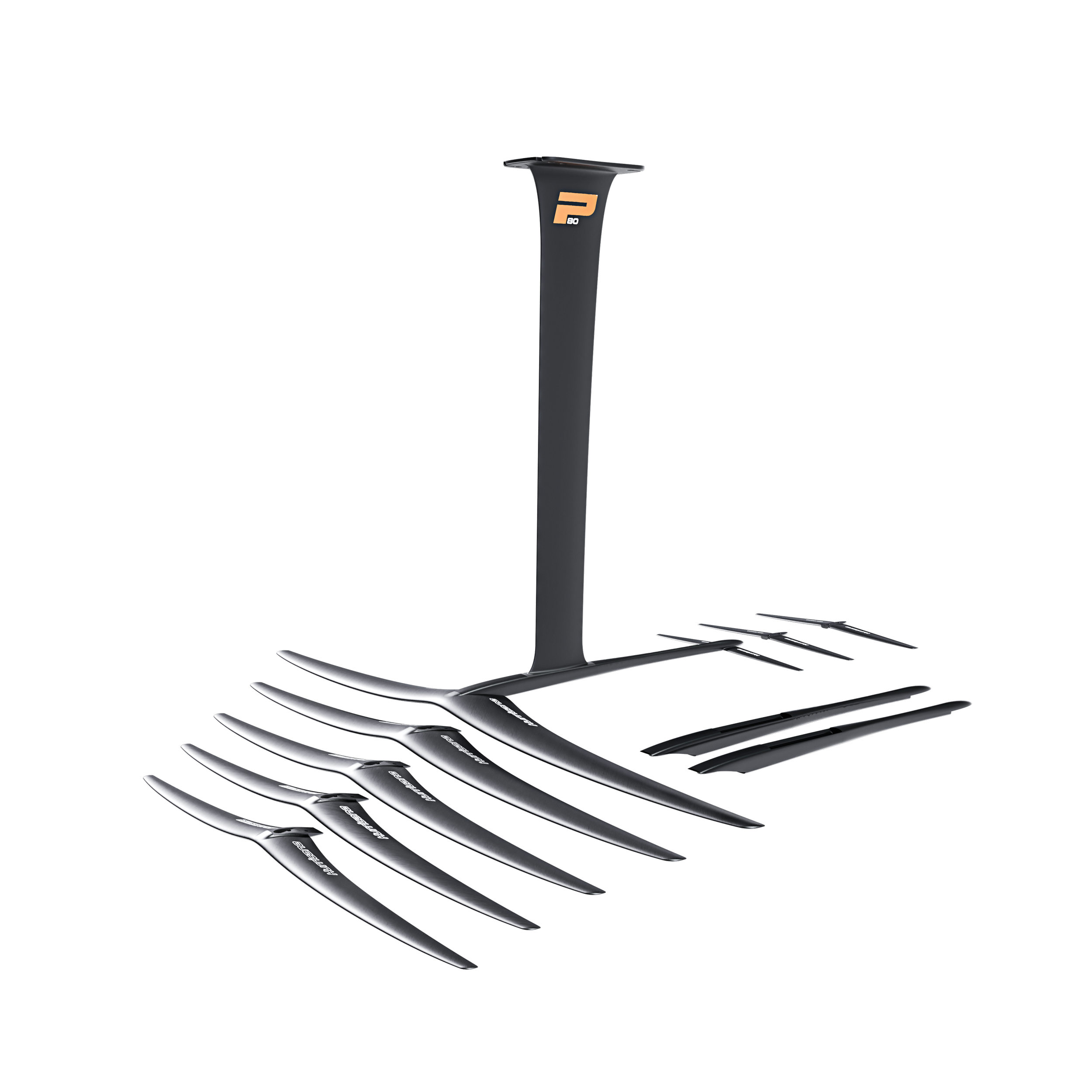HURRICANE
New Downwind Foils.
Downwind isn’t just about speed : it’s about adapting.
From fast-moving bumps to flat water, a true downwind run is never linear.
That’s why each front wing in the Hurricane range is fine-tuned to perform across specific wind and sea states, giving you a powerful tool for every condition.
*First delivery August 2025
Fuselage integrated into the foil flow
From a side view, the airflow clearly shows how the fuselage is seamlessly integrated into the foil’s flow, minimizing turbulence and drag for smoother transitions and stable lift.
The Hurricane’s front wing features a unique star-shaped dihedral junction beneath the fuselage, inspired by America’s Cup rudders. This design reduces drag by minimizing interference between the wing and fuselage, increases the front wing’s immersion for better lift, and shifts the wake below the rear stabilizer to prevent turbulence and instability. The relatively flat dihedral enhances roll control, while the tip shape reduces ventilation during sharp turns.
Specific Dihedral design of the foil
The Hurricane foils feature a carefully engineered anhedral geometry that enhances both control and stability. Unlike dihedral configurations, where the wings angle upward, our downward-angled anhedral wings offer more reactive handling and a steadier feel even in faster, more powered conditions. The precisely designed taper and sweepback angles promote efficient spanwise load distribution, boosting hydrodynamic performance. This shape also increases the foil’s immersion depth, reducing wake interference on the elevator for smoother pitch control and greater ride comfort. Overall, this specific anhedral design is key to delivering a smooth, forgiving, and highly responsive foil experience.
Titanium M6 Fastening Hardware
The Hurricane foils are equipped with M6 titanium hardware, chosen for its exceptional corrosion resistance and high torsional strength. This ensures secure, long-lasting connections that are critical for maintaining structural integrity in tough marine environments.
UHM Carbon Construction Details
The wings, stabilizers, and mast are all constructed using Ultra High Modulus (UHM) Pre-Preg Carbon, which is nearly twice as stiff as standard M40J high-modulus carbon. This allows for thinner, more hydrodynamic profiles without compromising rigidity. In the new construction, the carbon layup has been increased from 9 to 13 plies, adding +4 layers, resulting in significantly improved torsional stiffness and load distribution. The carbon weave is distinct due to specialized layering and orientation techniques, designed for high-load resistance and optimal energy transfer.
Two Types of Fuselage Materials: Aluminum and Titanium
Two fuselage materials are offered to meet varying performance and durability requirements.
- Aluminum provides a reliable and cost-effective option.
- Titanium offers superior stiffness, corrosion resistance, and is better suited for high-performance applications.
Both materials are fully compatible with the Hurricane foil range.
Tip Design
The tips feature a zero-camber section with a smooth, blended transition instead of a sharp cutoff. This design lessens the intensity of the tip vortex, reducing induced drag and boosting overall foil efficiency. Lower loading at the tip also minimizes the risk of ventilation when piercing the water surface, enhancing reliability in choppy or variable conditions. Additionally, the trailing edge near the tip is subtly reinforced to improve resistance to impacts and cracking, addressing a common durability weak point. Together, these design elements reduce induced drag, lower ventilation risk, and increase durability in critical areas.
Front Wing Positioning: Consistent Lift Center
The front wing’s position relative to the fuselage has been precisely calibrated to keep the center of lift consistent across all sizes, from the 540 cm² up to the 1100 cm² wing. This eliminates the need to adjust the mast position when changing wings, ensuring consistent handling and balanced performance.
Foil Profile Variations by size
The 550 and 630 foils feature distinct profiles compared to the 730, 900, and 1100 models. This difference arises from the fact that smaller foils operate within a different flow regime. Their shorter chord lengths result in a higher proportion of laminar flow, which the design capitalizes on to increase efficiency. By tailoring the profiles to each size category, the performance is optimized for the specific hydrodynamic conditions each foil encounters.
Smaller chord lengths are also more sensitive to manufacturing tolerances. To account for this, the profiles of the 550 and 630 are engineered to be more robust and tolerant of slight shape variations, ensuring consistent and reliable performance even with minor production deviations.
Segmented Foil Profiles: Root and Tip Sections
The foil is primarily divided into root and tip sections, each engineered with specific objectives:
Root section: Focuses on maximizing performance, benefiting from cleaner, less disturbed flow. On high aspect ratio wings, this section is also thicker to provide the necessary structural strength.
Tip section: Designed for greater tolerance and robustness against sudden angle-of-attack changes caused by pumping or waves. It carries less load than the root to reduce tip vortex strength, thereby lowering induced drag.
This segmentation improves foil handling during maneuvers and enhances gliding efficiency by reducing drag and increasing overall stability.
R&D Programm
The development of the Hurricane foil range was built on a rigorous R&D process driven by advanced engineering and elite rider feedback. From the outset, our design team applied state-of-the-art CFD (Computational Fluid Dynamics) simulations, the same tools used by our America’s Cup program, to model, test, and refine each foil profile with precision. Every decision was backed by aerodynamic analysis, structural studies, and performance modeling to ensure optimal behavior in real downwind conditions. This technical foundation was enhanced by continuous collaboration with world-class riders, whose on-water experience helped fine-tune the foil’s handling, balance, and glide. Far from trial-and-error development, the Hurricane range reflects a structured, data-led approach that brings top-tier racing technology to open-water foiling.
Hurricane Foil
The Hurricane Foil Range sets a new standard in downwind performance, combining speed, glide, and control in a compact, modular system. Each foil is tuned for stability, efficiency, and smooth handling across a wide range of conditions. The high aspect ratio wings provide effortless glide through flat sections while maintaining excellent control in steep or choppy water. The carefully refined dihedral adds forgiveness and maneuverability, making each transition feel natural and intuitive.
Built with ultra high modulus carbon, a constant 13 mm mast, and precision-engineered fuselage options in aluminum or titanium, the Hurricane range offers a uniquely stiff and responsive feel underfoot. Whether you're pushing for personal bests or just enjoying clean ocean lines, this system delivers the perfect balance of comfort, performance, and long-range efficiency.
*First delivery August 2025
Setup & Specs
We are here to help you !
Connect with our professional riders directly through the WhatsApp community or via the contact form at the bottom of the page !















